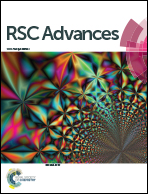Nickel(ii)-ethylenediamine tetraacetic acid sensitized silicon nanowire array: an efficient cocatalyst-free photocatalyst for photocatalytic hydrogen generation under simulated sunlight irradiation†
Abstract
In the present work, a green efficient photocatalyst was prepared using a silicon nanowire array and nickel(II)-ethylenediamine tetraacetic acid to reap three benefits simultaneously: (1) efficient H2 evolution under sunlight irradiation, (2) avoidance of the potential environment and health hazards that arise from the release of nanomaterials, (3) achievement of a Pt-free photocatalyst. The experimental results indicate that the as-prepared photocatalyst possesses high performance towards photocatalytic H2 evolution from water under simulated sunlight irradiation. A rate of H2 evolution of approximately 2.2 L m−2 h−1 can be achieved under optimal conditions. Here, nickel(II)-ethylenediamine tetraacetic acid plays an important role in the photocatalytic process as both a sensitizer and a sacrificial reagent. The photocatalytic activity of the nickel(II)-ethylenediamine tetraacetic acid sensitized silicon nanowire array is obviously higher than that of the silicon nanowire array. The rate of H2 evolution can be enhanced by a factor of 4 when nickel(II)-ethylenediamine tetraacetic acid is used instead of ethylenediamine tetraacetic acid disodium. Besides, the photocatalytic H2 evolution was studied as a function of the length of silicon nanowires, the concentration of nickel(II)-ethylenediamine tetraacetic acid and pH. And the photocatalytic mechanism was preliminarily discussed.


 Please wait while we load your content...
Please wait while we load your content...